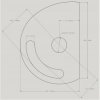I'll give you $400.00 for it .


You should have made a catch pan!!!!Forgot to mention, the radius jig also makes circles!
I did one in 1/4" plate and 2 at the same time in 14 gauge. Had to keep dipping in water to cool them.
View attachment 81123View attachment 81124View attachment 81125View attachment 81126View attachment 81127
I also added this nifty handle to push the tensioner down. Just push down and take the belt right off! I love how easy it is to change belts.
View attachment 81128View attachment 81129
Here's the mess it can make.
View attachment 81130
You should have made a catch pan!!!!
 I just had to share these pics.
I just had to share these pics. It could do this all day long. I love this damn thing!!!
It could do this all day long. I love this damn thing!!!  (the mag drill gets credit for the holes)
(the mag drill gets credit for the holes) 







Nice
 I can send you the plans for free if you like this design. (my way of giving back for all the help you give others on the forum)
I can send you the plans for free if you like this design. (my way of giving back for all the help you give others on the forum)
That is a very generous offer Bob, I'll that you up on that. Looks like something that would get a lot of use. Thanks
 I'll make a list and share that soon, it will probably be of help.
I'll make a list and share that soon, it will probably be of help. 


 A few things I would change to do this build over again.
A few things I would change to do this build over again.



 I bought that 4 inch round outer ring at my metal supplier last year and was just waiting for an excuse... You can also practice your driving but sorry, the horn doesn't work.
I bought that 4 inch round outer ring at my metal supplier last year and was just waiting for an excuse... You can also practice your driving but sorry, the horn doesn't work.




















